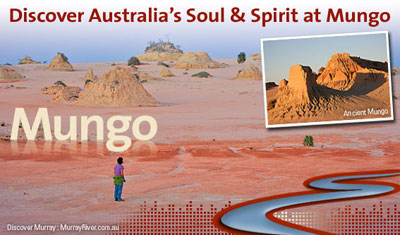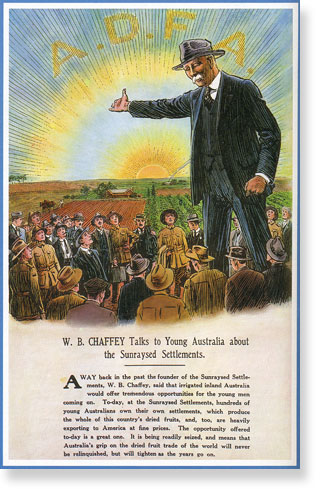
Mildura history dates back over 40,000 years
Australia's oldest known living culture near Mildura and Wentworth
 Long before European settlement, the rich waters of the Murray region around Mildura were home to Aboriginal people which included the Paakantyi and Latje Latje tribes. It is believed the name Mildura has been translated to mean ‘red earth and dust' in Latje Latje language.
Long before European settlement, the rich waters of the Murray region around Mildura were home to Aboriginal people which included the Paakantyi and Latje Latje tribes. It is believed the name Mildura has been translated to mean ‘red earth and dust' in Latje Latje language.
Nowadays the Mungo National Park and World Heritage Willandra Lakes (est. 1981) systems are home to some of the oldest know human remains not only in Australia but the world. There was human habitation 40 000 years ago. The region was in this landscape that the most fascinating and important finds were made; the cremated remains of a woman (of 26 000 years ago), a tall male (estimated to have lived 28 000 to 30 000 years ago) and numerous animal remains.
The diet of the first human inhabitants included Murray Cod, Golden Perch, shell-fish, emu eggs, wallabies and small marsupials. Archaeological studies uncovered the first known use of ochre in the world, and have enabled further understanding of ancient cultures. It was to ‘Lake Mungo country’ that the burnt, mineral-encrusted remains of ‘Mungo Woman’ were returned early in 1992, to be reburied in ‘her’ lands. It was because of ‘Mungo Woman’, Aboriginal heritage and records of past climate changes preserved in the landscape that Willandra Lakes World Heritage Region. The National Park Visitors Centre provides the information needed to understand the region’s natural and cultural history. It is located at the park entrance.
European settlement around Mildura
 European history dates back to 1847 when Frank Jenkin swam a mob of cattle across the Murray from New South Wales and took up land in the area known as Yerre Yerre. Through lack of a licence, he was forced back into New South Wales by Hugh Jamieson, the legal licence holder, and his six thousand sheep. Mildura was gazetted as the name for the town on 20 March 1858. In 1878 there was a change of ownership to Alexander McEdward, who in 1884 was forced to sell due to the severe drought and rabbit plague of the 1880s.
European history dates back to 1847 when Frank Jenkin swam a mob of cattle across the Murray from New South Wales and took up land in the area known as Yerre Yerre. Through lack of a licence, he was forced back into New South Wales by Hugh Jamieson, the legal licence holder, and his six thousand sheep. Mildura was gazetted as the name for the town on 20 March 1858. In 1878 there was a change of ownership to Alexander McEdward, who in 1884 was forced to sell due to the severe drought and rabbit plague of the 1880s.
The potential of the region was seen by two young Canadian irrigation engineers, the Chaffey brothers, and a brilliant young politician called Alfred Deakin. In October 1886 an agreement was made between the Chaffey Brothers and the Victorian Government to secure the application of private capital to the construction of irrigation works, and the establishment of a system of instruction in practical irrigation. However, the problems of the proposal surfaced, and the plan collapsed which allowed the South Australian Government to step in and the Chaffey brothers began an irrigation project at Renmark.
Shortly afterwards, the Victorian Government asked the Chaffeys to reconsider, and to their credit and Victoria’s gain they accepted. The Mildura Irrigation Company was formed on 28 December 1887. The first of the settlers arrived in the same year and established a canvas town on the area now known as Lock Island. The 500 hectare township of Mildura was designed and laid out on the Californian Pattern with Deakin Avenue, the main thoroughfare, extending 8 km to the south-west. The American tradition of naming the streets with numbers was also borrowed.
At first the Chaffey irrigation venture was a success, but due to the 1890s depression, reduced markets for their produce and lack of credit, the Chaffeys were ruined. George Chaffey left Australia in 1897, never to return. Ben Chaffey stayed on, and through his determination and belief in Mildura plus his enormous capacity, paid off his creditors, and when good times returned became a leader again. He was twice elected mayor, founded the Australian Dried Fruits Association, and was president of the Mildura Horticultural and Agricultural Society. He died in 1926. Explore Mildura's Chaffey Trail.
Mildura | Mildura's Community story | Wentworth | Mungo National Park
Early Irrigation History | Locks, Weirs & Dams | Murray River History | How the Murray was formed

Mildura Town Guide
Towns Close By: Buronga, Irymple, Wentworth, Dareton, Red Cliffs, Trentham Cliffs, Cullulleraine, Gol Gol, Renmark, Robinvale, Merbein, Nangiloc, Ouyen, Swan Hill, Hattah, Meringur, Werrimull, Euston, BalranaldTell your friends you found this at murrayriver.com.au!
Copyright Discover Murray 2026. This site or any portion of this site must not be reproduced, duplicated, copied, sold, resold, or otherwise exploited for any commercial purpose that is not expressly permitted by DISCOVER MURRAY.






 Amy Shark The Solo Acoustic "Songs & Stories" Tour
Amy Shark The Solo Acoustic "Songs & Stories" Tour Kevin Bloody Wilson Aussie Icon Tour with special guest Jenny Talia
Kevin Bloody Wilson Aussie Icon Tour with special guest Jenny Talia Little By Little
Little By Little The Australian Beach Boys Show
The Australian Beach Boys Show Lee Kernaghan Boys From The Bush The Concert
Lee Kernaghan Boys From The Bush The Concert
